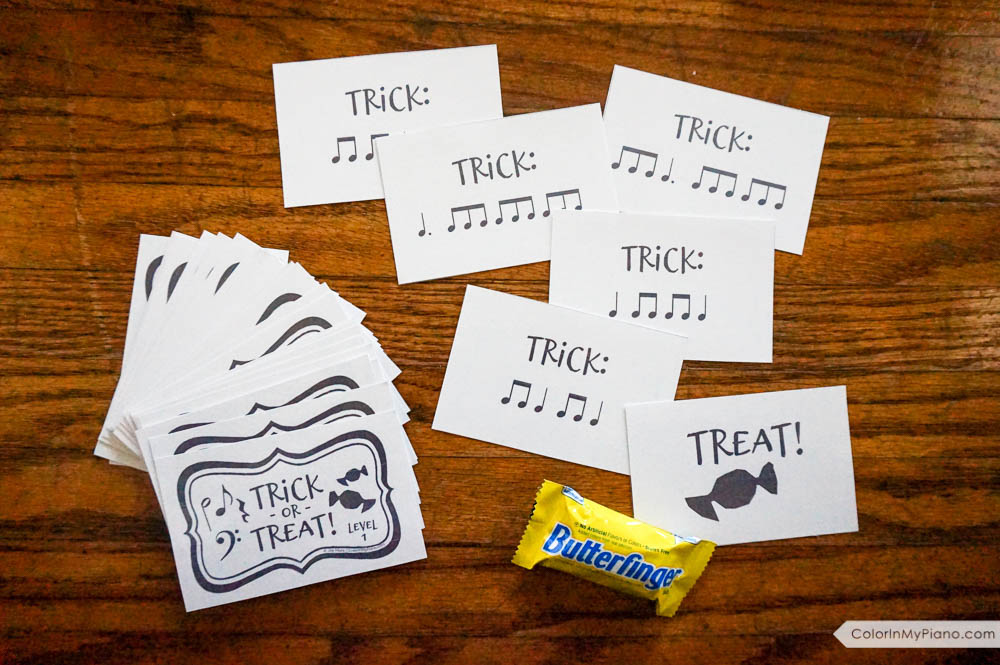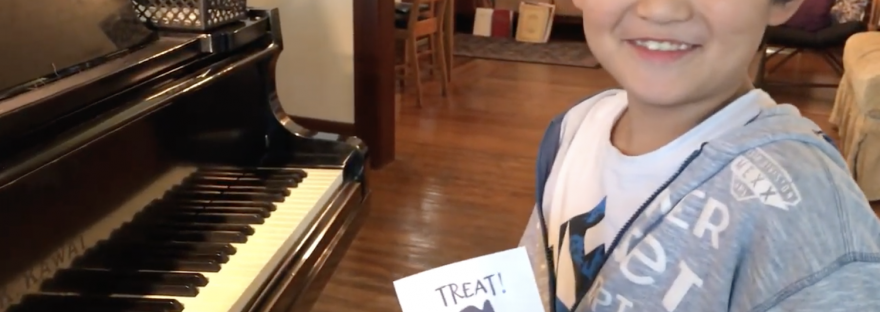Yesterday, my student Robbie and I made a quick video for you, demonstrating how to play my new Trick-or-Treat! Rhythm Game.
Here’s what you’ll find in the video:
- 0:12 | What to do if a student happens to draw a TREAT card first thing! (This is a rare occurance.)
- 0:33 | How to teach a student how to perform the rhythm patterns on the TRICK cards accurately. They need to be able to (1) identify the meter, (2) count in before speaking/counting the rhythm pattern, and (3) maintain the meter as they speak/tap the rhythm pattern. (More tips on this below.)
- 1:00, 1:20, and 1:42 | Watch Robbie chant more rhythm cards.
- 2:00 | Robbie draws a TREAT card, ending the game.
>>> Watch the video >>>
Below is more elaboration and tips on how to guide your students to perform rhythm patterns accurately. I hope you’ll enjoy hearing my thoughts on this, whether or not you plan to use my Trick-or-Treat! Rhythm Game!
1. Identify the meter as either duple meter or triple meter.
Ask students: “Is this is duple meter or triple meter?” Sometimes I follow up with: “How do you know?”
With these rhythm cards, it’s easy: just look at the way the eighth note beams are grouped!

To make sure it’s not only a visual thing, though, I teach my students to listen to and feel the meter as well.
Note: My use of “duple meter” and “triple meter” here is MLT-based. In MLT, we pay attention to the way the “microbeats” (aka, “little beats”) are grouped. If we hear/feel groups of two, we are in duple meter. If we hear/feel groups of three, we are in triple meter.
That said, it’s important to know that “microbeats” can be eighth notes or they can be quarter notes, or anything else for that matter. Rhythm patterns are always enrhythmic — they can be written in more than one way. Regarding with rhythm patterns, is the best way for you to familiarize the pattern. What’s important is how the rhythm feels. That’s what ultimately determines the macrobeats and microbeats.
If you prefer to do things differently, feel free! But I would encourage you to give this approach a try.
2. Count-in before speaking/tapping the rhythm pattern.
At first, I always count-in for my students. For example: “1 2 1 2 Here you go…” (duple meter) or “1 2 3 1 2 3 Here, you go…” (triple meter). A lengthy count-in is better than a shorter one, to ensure that the meter is sufficiently established in our minds/bodies/audiation. You can hear me do this at 1:30 in the video above.
As soon as students seem ready, I teach them how to give a count-in for themselves. This is a useful skill for them to have. If they can establish the meter and tempo appropriately for themselves, they are more likely to be able to continue maintaining that meter and tempo throughout their performance — whether it’s a rhythm pattern or a piece of music.
If the student draws a few cards in a row that are all in the same meter, it may not be as necessary to establish the meter each time. However, when switching from duple meter to triple meter (or vice versa), it becomes extremely important to re-establish meter. It’s so interesting to see what happens when a student tries to perform a duple rhythm pattern when their mind/body is still in triple meter! It’s a good learning moment.
3. Speak/tap the rhythm pattern accurately.
The count-in leads directly into speaking or tapping the rhythm pattern on the card. As students perform the rhythm, I watch carefully to see if they are maintaining awareness of the meter. Feeling the meter is of utmost importance. If they can maintain the meter, they are more likely to perform the rhythm pattern accurately and musically. This skill also enables them to self-correct their own errors.
So, I often ask students to (1) move to the “macrobeats” (aka, big beats), (2) move to the “microbeats” (aka, little beats), or (3) both. In the video above, you can see that Robbie is naturally choosing to lean body weight along with the macrobeats he is feeling.
You may have noticed I asked Robbie to “speak” the rhythm instead of tap it or play it on the piano. This is my preference the majority of the time. The voice is a natural instrument. Issues such as physical coordination or technique are out of the way, and we can directly connect to our mental musical instrument.
In the video, Robbie is using a “neutral syllable” — in this case, “BAH” — to chant the rhythm. Feel free to use anything you like: TAH, DU, etc..
My students and I also like to use the Gordon-Froseth rhythm syllables (Google it), which is in my opinion the best “beat function” syllable system out there. Just as solfege is useful towards building awareness of how sounds live within a key, “beat function” rhythm syllables help us build awareness of how sounds or durations live within a meter.
However, variety is the spice of life! Feel free to also tap, play on the piano, use a hand drum or egg shaker, or whatever else you can come up with.
If students do not perform the rhythm accurately, we work on it together until they get it.
If students find Level 1 easy, we progress to the next level at the following week’s lesson.
Game Variations
- YOUNG BEGINNERS: Instead of asking the student to read the rhythms, ask them to echo after you. This is so good for developing their ears and preparing for reading down the road! Don’t skip this stage.
- SMALL GROUPS: Play the game normally, except ask the entire group to help perform the rhythm cards drawn by each individual.
These tips n’ tricks AND MORE are outlined inside the 45-page Trick-or-Treat! Rhythm Game PDF download when you make the purchase. Interested? Visit my shop page HERE. The price is $9.00, but I’m offering an introductory special: Buy between now and November 15, 2019 and get a dollar off! You must enter the promo code TREAT2019 during checkout to receive the discount.
I hope you gained some useful rhythm ideas to try out with your students! Thanks for reading.



Loved the video! What a fun game. Thanks for sharing! ?